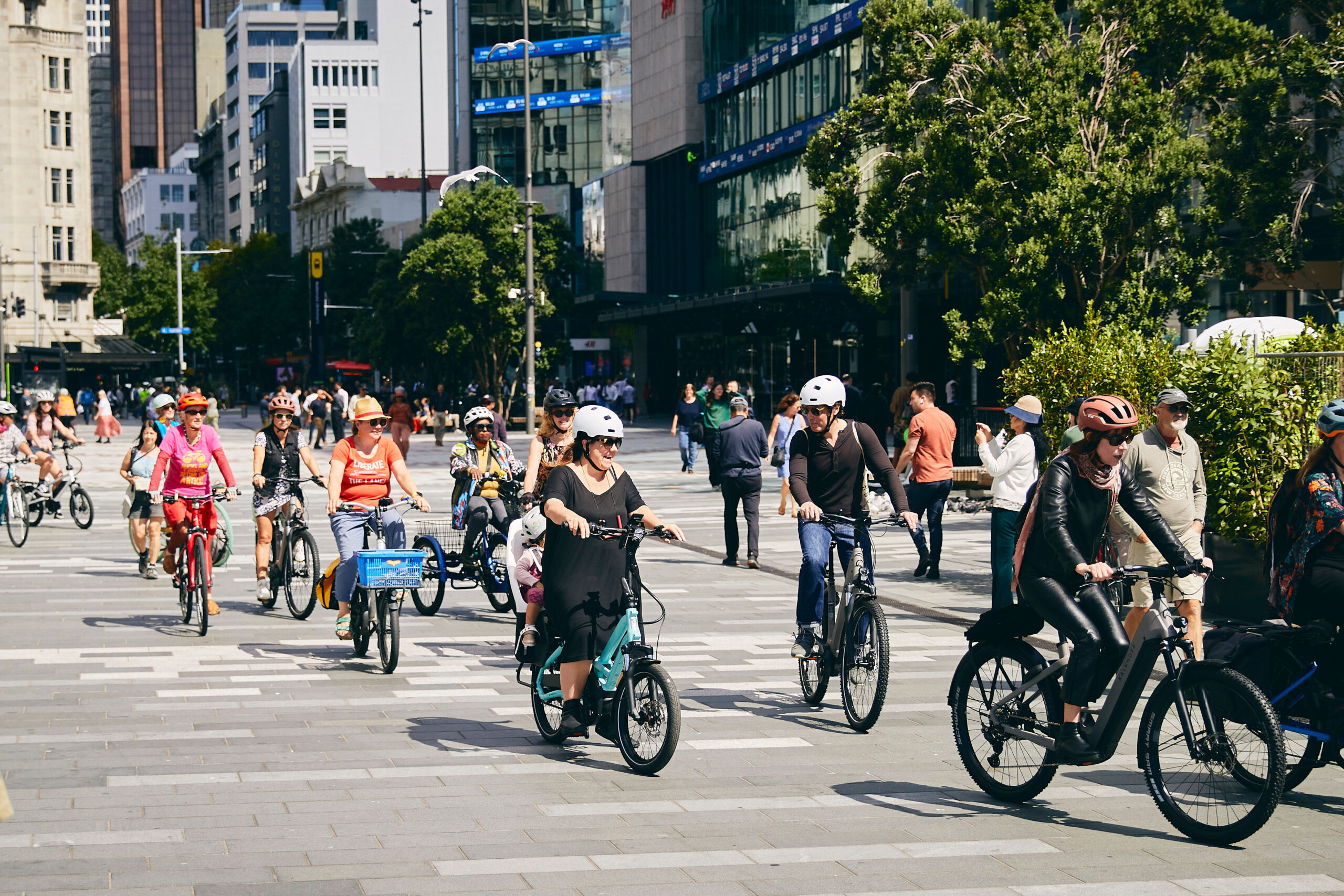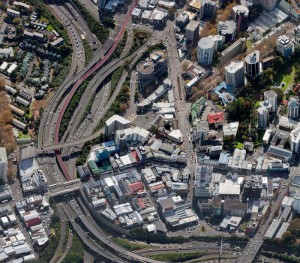
As shown in this photo blog, NZTA and the Auckland Motorways Alliance (thanks!) recently allowed CAA and Transport Blog the chance to walk over a surplus part of our motorway building boom.
Both our groups have some interest in what you might call “urban archeology” (comes with the terrain when you are trying to understand how a city is shaped) – but we didn’t go there just for the view.
Instead, we were keen to see – you guessed it – how this could become Auckland’s evolution of the New York City High Line concept. A new walk- and cycleway to one of the currently least walkable and cycleable parts of our City Centre.
The Nelson Street ramp became surplus for motorway use when a new ramp was built some years ago – but the costs involved in tearing it down means it is still there, and not going anywhere. It was at a time proposed to serve as a bus depot – but a year or two ago, it was agreed by AT and NZTA that it would make a great future link in the Auckland Cycle Network – connecting the Northwestern and other routes entering the City Centre from the south and west to the western parts of our downtown and waterfront, along a Nelson Street cycleway.
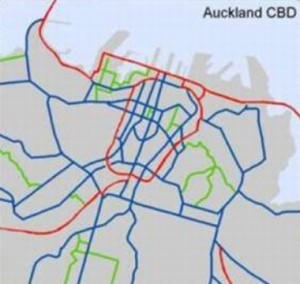
As you can see in the map above, the off-ramp and Nelson Street are both shown as red lines – future “cycle metro” routes (a route that is either fully off-road – or protected from traffic with physical separation). It goes from Upper Queen Street Bridge along Canada Street (or more likely in practice, along Canada Street, East Street and Galatos Street) onto the off-ramp, and then travels along Nelson Street to the waterfront.
Now, as Patrick has noted in his previous post, walking / cycling on the off-ramp is more pleasant than we thought – mainly because you are above or away from traffic noise and fumes for most part, rather than directly next to it.
But it isn’t really the beauty of the route that is interesting here (that’s more for engineers and people who like looking at flyovers and skylines…).
The ramp-over route is useless without somewhere to go. So if it gets built, it really needs to link to a cycleway on Nelson Street itself, to give that transport-blighted area some human scale. Because who really cycles on Nelson Street at the moment? The numbers are so low, we might just as well treat them as rounding errors on two wheels – very brave rounding errors, but irrelevant nonetheless.
So it’s great so see that Auckland Transport has seen both the need and the opportunity for this cycleway, and included this route in their planning maps. But we know how long these kinds of projects take – years if you are lucky. Decades if not (still waiting for the Wellesley Street East walk and cycleway link to the Domain…).
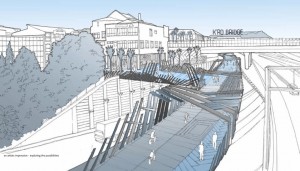
And while this is a high-profile project that will appeal to many, it is likely to languish for quite a while before getting built, despite being prioritised highly in AT’s overall cycle project list. Funding is tight, bridges are expensive, even short ones like the one shown below (Day Street overbridge design produced by our good friends at Matter, for NZTA).
So we started to think. Could this link be done a lot more cheaply, a lot more quickly? And yes, we think it can. As a pilot project.
The most difficult part is right at the start. It’s no use if the ramp is a dead end – so how to get onto it from the south? And on the cheap?
What we came up with was that the best place to start from for a pilot project was not at the very southernmost end, near Canada Street or Galatos Street, where we would have to build a pretty sizable structure to get across a large gap of several motorway lanes underneath. Nor would a temporary bridge at Day Street as above be easy (unless of course, NZTA is willing to lend us one of their bailey bridges?).
We found the solution to our issue in Newmarket, back when the new train station was built a couple years ago. At that time, a company called Layher built KiwiRail several access ramps down to temporary platforms south of Remuera Road. Below, you can see an image from their company website – essentially, these structures are simply strong scaffolds with wheelchair-accessible ramps on them.
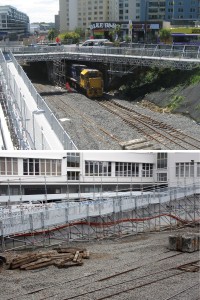
What Cycle Action Auckland is proposing is that we construct such a scaffold ramp down from K’Road overbridge, to the old Nelson Street ramp. It would require a minor reshuffling of one of the overbridge bus stops, and creating a gap in the side of the K’Road railings to attach the ramp to.
But importantly, it could be done without having the temporary ramp be above any live traffic lanes. The old off-ramp is almost 8m wide. So we can easily build a, say, 3m wide ramp directly in the centre of the off-ramp below, with no part having over (or getting anywhere close) to the edge of the southbound SH1 traffic lanes one level further down.
It might cost us a bit to buy/rent that scaffold, but it’s likely to still be a steal compared to the permanent construction needed to access it from Canada Street or Day Street, which are going to cost us many millions (remember, time IS money here – if we wait until we get the money, we will have lots of time…).
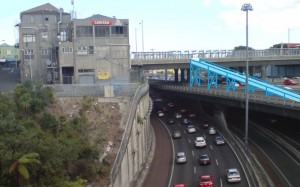
So now we are down on the old off-ramp, and now it gets cheap as chips.
We can leave adding artwork and seats and planting to beautify the ramp later (or make it into a community initiative!). In the meantime, we simply cruise (or walk) northwards along a gentle incline towards Nelson Street.
At that intersection, we add a new signalised pedestrian / cycle crossing over the eastern side of the intersection of Nelson Street and Union Street.
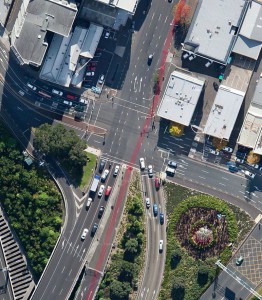
Easy.
Why? Because the current Nelson Street off-ramp, to the west of the old one, doesn’t allow right turns into Union Street. So whenever that ramp runs, you can also run a signalised walking / cycling crossing in parallel on the right-hand side – no long discussions with the traffic control people about whether we can afford to lose precious car capacity. We simply sneak through in an unused part of the signal cycle!
And on Nelson Street?
We propose to create a two-way, planter-box protected cycleway on the eastern side of the road, at least as far as Cook Street (but ideally going even further north). The design would look similar to the below example from Vancouver, in Dunsmuir Street.
It can be installed overnight for the total cost of a couple dozen planter boxes (reusable for our next temporary cycleway – after this one gets made permanent a few months or years later).
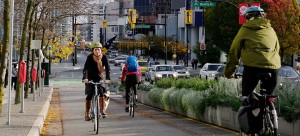
But won’t that create traffic issues on Nelson Street? After all, there’s lots of cars moving along there in the peak hour. Won’t NZTA and AT have concerns, and won’t we have to run an extensive traffic model and somehow increase the size of the intersections?
No. Apart from the fact that we have been told that Nelson Street modelling has shown that the street CAN take some reduction in capacity without causing the (roading) world to end, what we propose is actually pretty limited again.
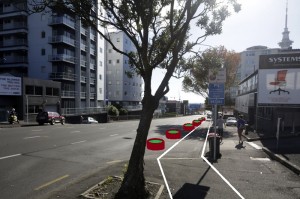
We propose to run the cycleway along the current parking lane, which means that no “throughput capacity” is lost at all until we get to the Cook Street / Nelson Street Intersection (where the right-hand through lane would have to become a through-and-right lane).
We can achieve this while losing barely more than 10 car parks over a stretch of 250 meters, because most of that street is already “no parking”. We might even be able to fit in one or two loading zones on the very wide footpath / verge (some sections still have ~6 m left before reaching private property).
So again, it is easy (if we keep some spine, and don’t give in to the “removing some car parks will doom the area” crowd). And if it leads to traffic jams because we lose 80m of dedicated right turn lane into Cook Street? Well, it won’t – but that’s the benefit of a pilot project. If it doesn’t work, you haven’t sunk millions into it, and can just modify the design as needed.
To summarise, Cycle Action Auckland thinks that the time is ready to throw down a Half-Nelson. We need some movement, some breath of fresh air – and a showcase project to prove that Auckland can be fast, flexible and at the front.
We can do all that, and give the western City Centre a new cycleway in the next 10 months, rather than in 10 years.


